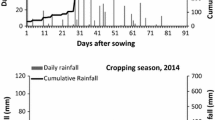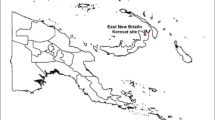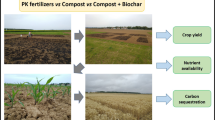Abstract
Improving soil fertility using crop residues is essential for circular agriculture in arid agroecosystems such as oases. This study aimed to evaluate effects of composts based on palm leaves on nitrogen (N) mineralization, soil properties, silage corn yield, and nutrient uptake in oasis agroecosystems. A 2-year field study was performed to compare impacts of two composts, one based on dry palms and rock phosphate (C1, C:N > 30) applied at 25 t ha−1, and the other based on dry palms, rock phosphate, and sheep manure (C2, C:N = 17) applied at three rates (10, 25, and 40 t ha−1). The fifth treatment included application of only mineral N fertilizer (MNF). The sixth treatment received no fertilizer (control). The compost-amended plots had significantly higher organic matter, total N, and available phosphorus (P) and potassium contents in the soil after silage corn harvest in both seasons than MNF and control plots did. Applying compost C2 resulted in net N mineralization in both seasons, while applying compost C1 resulted in N immobilization in the second season. Mean dry biomass yield was 21.6 and 21.0 t ha−1 with MNF and 40 t ha−1 of C2 in the first year, respectively, and 21.3 and 19.1 t ha−1 in the second season, respectively. Increasing the compost application rate significantly increased yields in both seasons. Applying either compost resulted in higher P uptake at silage corn harvest than applying MNF. Recycling date palm residues as compost improves soil fertility and forage production, which promotes sustainable farming systems in arid regions.




Similar content being viewed by others
References
Abiven S, Menasseri S, Chenu C (2009) The effects of organic inputs over time on soil aggregate stability – a literature analysis. Soil Biol Biochem 41:1–12. https://doi.org/10.1016/j.soilbio.2008.09.015
Adamtey N, Cofie O, Ofosu-Budu KG, Ofosu-Anim J, Laryea KB, Forster D (2010) Effect of N-enriched co-compost on transpiration efficiency and water-use efficiency of maize (Zea mays L.) under controlled irrigation. Agric Water Manag 97:995–1005. https://doi.org/10.1016/j.agwat.2010.02.004
Albiach R, Canet R, Pomares F, Ingelmo F (2001) Organic matter components and aggregate stability after the application of different amendments to a horticultural soil. Bioresour Technol 76:125–129. https://doi.org/10.1016/S0960-8524(00)00090-0
Ali YSS (2008) Use of date palm leaves compost as a substitution to peatmoss. Am J Plant Physiol 3:131–136. https://doi.org/10.3923/ajpp.2008.131.136
Amlinger F, Götz B, Dreher P, Geszti J, Weissteiner C (2003) Nitrogen in biowaste and yard waste compost: dynamics of mobilisation and availability—a review. Eur J Soil Biol 39:107–116. https://doi.org/10.1016/S1164-5563(03)00026-8
Ben Mbarek H, Ben Mahmoud I, Chaker R, Rigane H, Maktouf S, Arous A, Soua N, Khlifi M, Gargouri K (2019) Change of soil quality based on humic acid with date palm compost incorporation. Int J Recycl Org Waste Agricult 8:317–324. https://doi.org/10.1007/s40093-019-0254-x
Benabderrahim MA, Elfalleh W, Belayadi H, Haddad M (2018) Effect of date palm waste compost on forage alfalfa growth, yield, seed yield and minerals uptake. Int J Recycl Org Waste Agricult 7:1–9. https://doi.org/10.1007/s40093-017-0182-6
Blake GR, Hartge KH (2018) Bulk density. In: Klute A (ed) SSSA Book Series. Soil Science Society of America, American Society of Agronomy, Madison, WI, USA, pp 363–375
Bouaziz A, Hammani A, Kuper M (2018) Les oasis en Afrique du Nord : dynamiques territoriales et durabilité des systèmes de production agricole. Cah Agric 27:14001. https://doi.org/10.1051/cagri/2017063
Bronick CJ, Lal R (2005) Soil structure and management: a review. Geoderma 124:3–22. https://doi.org/10.1016/j.geoderma.2004.03.005
Brust GE (2019) Chapter 9 - Management strategies for organic vegetable fertility. In: Biswas D, Micallef SA (eds) Safety and Practice for Organic Food. Academic Press, pp 193–212
Butler TJ, Weindorf DC, Han KJ, Muir JP (2009) Dairy manure compost quality effects on corn silage and soil properties. Compost Sci Util 17:18–24. https://doi.org/10.1080/1065657X.2009.10702395
Cahyono P (2020) Effect of compost on soil properties and yield of pineapple (Ananas comusus L. Merr.) on red acid soil, Lampung, Indonesia. Int J Geomate 19:33–39. https://doi.org/10.21660/2020.76.87174
Chao CT, Krueger RR (2007) The date palm (Phoenix dactylifera L.): overview of biology, uses, and cultivation. HortScience 42:1077–1082. https://doi.org/10.21273/HORTSCI.42.5.1077
Corbeels M, Hofman G, van Cleemput O (1999) Simulation of net N immobilisation and mineralisation in substrate-amended soils by the NCSOIL computer model. Biol Fertil Soils 28:422–430. https://doi.org/10.1007/s003740050515
Courtney RG, Mullen GJ (2008) Soil quality and barley growth as influenced by the land application of two compost types. Bioresour Technol 99:2913–2918. https://doi.org/10.1016/j.biortech.2007.06.034
De Clercq T, Heiling M, Dercon G, Resch C, Aigner M, Mayer L, Mao Y, Elsen A, Steier P, Leifeld J, Merckx R (2015) Predicting soil organic matter stability in agricultural fields through carbon and nitrogen stable isotopes. Soil Biol Biochem 88:29–38. https://doi.org/10.1016/j.soilbio.2015.05.011
Diacono M, Montemurro F (2010) Long-term effects of organic amendments on soil fertility. Review Agron Sustain Dev 30:401–422. https://doi.org/10.1051/agro/2009040
Diacono M, Montemurro F (2019) Olive pomace compost in organic emmer crop: yield, soil properties, and heavy metals’ fate in plant and soil. J Soil Sci Plant Nutr 19:63–70. https://doi.org/10.1007/s42729-019-0010-3
Eghball B (2002) Soil properties as influenced by phosphorus- and nitrogen-based manure and compost applications. Agron J 94:128. https://doi.org/10.2134/agronj2002.0128
El Janati M, Akkal-Corfini N, Bouaziz A, Oukarroum A, Robin P, Sabri A, Chikhaoui M, Thomas Z (2021) Benefits of circular agriculture for cropping systems and soil fertility in oases. Sustainability 13:4713. https://doi.org/10.3390/su13094713
Fagnano M, Adamo P, Zampella M, Fiorentino N (2011) Environmental and agronomic impact of fertilization with composted organic fraction from municipal solid waste: a case study in the region of Naples, Italy. Agric Ecosyst Environ 141:100–107. https://doi.org/10.1016/j.agee.2011.02.019
FAO (2015) World reference base for soil resources 2014. International soil classification system for naming soils and creating legends for soil maps. Rome, Italy
Hashem M, Ahmed MMM, Gawad KMA, Monsef OA (2016) Response of maize to the integrated use of date palm compost and mineral-N fertilizer. Int j plant soil sci 1–12https://doi.org/10.9734/IJPSS/2016/22719
Indorante SJ, Hammer RD, Koenig PG, Follmer LR (1990) Particle-size analysis by a modified pipette procedure. SSSA 54:560–563. https://doi.org/10.2136/sssaj1990.03615995005400020047x
Iqbal S, Arif MS, Khan HZ, Yasmeen T, Thierfelder C, Li T, Khan S, Nadir S, Xu J (2019) Compost amended with N enhances maize productivity and soil properties in semi-arid agriculture. J Agron 111:2536–2544. https://doi.org/10.2134/agronj2019.03.0176
El Kinany S, El Hilali R, Achbani EH, Haggoud A, Bouamri R (2022) Enhancement of date palm growth throw the use of organic fertilizer and microbial agents. J Soil Sci Plant Nutr 10https://doi.org/10.1007/s42729-021-00746-z
Kranz CN, McLaughlin RA, Johnson A, Miller G, Heitman JL (2020) The effects of compost incorporation on soil physical properties in urban soils - a concise review. J Environ Manage 261:110209. https://doi.org/10.1016/j.jenvman.2020.110209
Lehrsch GA, Kincaid DC (2007) Compost and manure effects on fertilized corn silage yield and nitrogen uptake under irrigation. Commun Soil Sci Plant Ana 38:2131–2147. https://doi.org/10.1080/00103620701548977
Lentz RD, Lehrsch GA (2012) Net nitrogen mineralization from past years’ manure and fertilizer applications. SSSA 76:1005–1015. https://doi.org/10.2136/sssaj2011.0282
Liu E, Terumasa T (2022) Effects of applying recycled urban green waste compost made from pruning materials to soil on the growth of plants. J Soil Sci Plant Nutr 22:1088–1097. https://doi.org/10.1007/s42729-021-00717-4
Lyimo HJF, Pratt RC, Mnyuku RSOW (2012) Composted cattle and poultry manures provide excellent fertility and improved management of gray leaf spot in maize. Field Crops Res 126:97–103. https://doi.org/10.1016/j.fcr.2011.09.023
Mahgoub NA, Mohamed AI, Sikhary ESME, Ali OM (2017) Roots and nutrient distribution under drip irrigation and yield of faba bean and onion. Open J Soil Sci 7:52–67. https://doi.org/10.4236/ojss.2017.72004
Mamo M, Rosen CJ, Halbach TR (1999) Nitrogen availability and leaching from soil amended with municipal solid waste compost. J Environ Qual 28:1074–1082. https://doi.org/10.2134/jeq1999.00472425002800040003x
Mawof A, Prasher S, Bayen S, Nzediegwu C (2021) Effects of biochar and biochar-compost mix as soil amendments on soil quality and yield of potatoes irrigated with wastewater. J Soil Sci Plant Nutr 21:2600–2612. https://doi.org/10.1007/s42729-021-00549-2
Memon M, Memon KS, Mirani S, Jamro GM (2012) Comparative evaluation of organic wastes for improving maize growth and NPK content. Afr j Biotechnol 11:9343–9349. https://doi.org/10.4314/ajb.v11i39
Montemurro F, Maiorana M, Convertini G, Ferri D (2006) Compost organic amendments in fodder crops: effects on yield, nitrogen utilization and soil characteristics. Compost Sci Util 14:114–123. https://doi.org/10.1080/1065657X.2006.10702272
NF ISO 11260 (2018) Soil quality: Determination of effective cation exchange capacity and base saturation level using barium chloride solution. AFNOR, Paris 12
NF ISO 11261 (1995) Soil quality: determination of total nitrogen–Modified Kjeldahl method. AFNOR, Paris 257–260
NF ISO 11265 (1997) Soil quality: determination of the specific electrical conductivity. AFNOR, Paris 7
Odlare M, Pell M, Svensson K (2008) Changes in soil chemical and microbiological properties during 4 years of application of various organic residues. Waste Manage 28:1246–1253. https://doi.org/10.1016/j.wasman.2007.06.005
Olsen SR, Cole CV, Watanabe FS, Dean LA (1954) Estimation of available phosphorus in soils by extraction with sodium bicarbonate. Government Printing Office, Washington DC, USA
ORMVA/TF (2012) Monographie de la subdivision agricole de Goulmima. In : Monographie des subdivisions agricoles de l’office régional de mise en valeur agricole du Tafilalet.
Ou-Zine M, Symanczik S, Rachidi F, Fagroud M, Aziz L, Abidar A, Mäder P, Achbani EH, Haggoud A, Abdellaoui M, Bouamri R (2021) Effect of organic amendment on soil fertility, mineral nutrition, and yield of majhoul date palm cultivar in Drâa-Tafilalet region, Morocco. J Soil Sci Plant Nutr 21:1745–1758. https://doi.org/10.1007/s42729-021-00476-2
Pinitpaitoon S, Suwanarit A, Bell RW (2011) A framework for determining the efficient combination of organic materials and mineral fertilizer applied in maize cropping. Field Crops Res 124:302–315. https://doi.org/10.1016/j.fcr.2011.06.018
Pomeranz Y, Meloan CE (1995) Food analysis. Springer, US, Boston, MA
Redel Y, Kunz E, Hartmann TE, Müller T, Bol R (2021) Long-term compost application and the impact of soil P legacy on the enhancement of early maize growth. J Soil Sci Plant Nutr 21:873–881. https://doi.org/10.1007/s42729-020-00407-7
Řezáčová V, Czakó A, Stehlík M, Mayerová M, Šimon T, Smatanová M, Madaras M (2021) Organic fertilization improves soil aggregation through increases in abundance of eubacteria and products of arbuscular mycorrhizal fungi. Sci Rep 11:12548. https://doi.org/10.1038/s41598-021-91653-x
Saleem A, Irshad M, Hassan A, Mahmood Q, Eneji AE (2017) Extractability and bioavailability of phosphorus in soils amended with poultry manure co-composted with crop wastes. J Soil Sci Plant Nutr 17:609–623. https://doi.org/10.4067/S0718-95162017000300005
Shahzad SM, Arif MS, Riaz M, Ashraf M, Yasmeen T, Zaheer A, Bragazza L, Buttler A, Robroek BJM (2017) Interaction of compost additives with phosphate solubilizing rhizobacteria improved maize production and soil biochemical properties under dryland agriculture. Soil Tillage Res 174:70–80. https://doi.org/10.1016/j.still.2017.06.004
Singer JW, Logsdon SD, Meek DW (2007) Tillage and compost effects on corn growth, nutrient accumulation, and grain yield. Agron J 99:80–87. https://doi.org/10.2134/agronj2006.0118
Skalar Analytical B.V (1995) Ammonia. In: The SAN++ segmented flow analyzer — water analysis. p 73–5.
Song Z, Gao H, Zhu P, Peng C, Deng A, Zheng C, Mannaf MA, Islam MN, Zhang W (2015) Organic amendments increase corn yield by enhancing soil resilience to climate change. Crop J 3:110–117. https://doi.org/10.1016/j.cj.2015.01.004
Sparks DL, Page AL, Helmke PA, Loeppert RH, Soltanpour PN, Tabatabai MA, Johnston CT, Sumner ME (eds) (1996) Methods of soil analysis: Part 3 chemical methods. Soil Science Society of America, American Society of Agronomy, Madison, WI, USA
Sraïri MT, AzahraM’ghar F, Benidir M, Bengoumi M (2017) Analyse typologique de la diversité et des performances de l’élevage oasien. Cah Agric 26:9
Tejada M, Hernandez M, Garcia C (2009) Soil restoration using composted plant residues: effects on soil properties. Soil Tillage Res 102:109–117. https://doi.org/10.1016/j.still.2008.08.004
Ten Berge HFM, Hijbeek R, van Loon MP, Rurinda J, Tesfaye K, Zingore S, Craufurd P, van Heerwaarden J, Brentrup F, Schröder JJ, Boogaard HL, de Groot HLE, van Ittersum MK (2019) Maize crop nutrient input requirements for food security in sub-Saharan Africa. Glob Food Sec 23:9–21. https://doi.org/10.1016/j.gfs.2019.02.001
Thomas CL, Acquah GE, Whitmore AP, McGrath SP, Haefele SM (2019) The effect of different organic fertilizers on yield and soil and crop nutrient concentrations. Agronomy 9:776. https://doi.org/10.3390/agronomy9120776
Villa YB, Khalsa SDS, Ryals R, Duncan RA, Brown PH, Hart SC (2021) Organic matter amendments improve soil fertility in almond orchards of contrasting soil texture. Nutr Cycl Agroecosyst 120:343–361. https://doi.org/10.1007/s10705-021-10154-5
Walkley A, Black IA (1934) An examination of the degtjareff method for determining soil organic matter, and a proposed modification of the chromic acid titration method. Soil Sci 37:29–38
Wang Q, Liu J, Zhu H (2018) Genetic and molecular mechanisms underlying symbiotic specificity in legume-rhizobium interactions. Front Plant Sci 9:313. https://doi.org/10.3389/fpls.2018.00313
White PJ, Brown PH (2010) Plant nutrition for sustainable development and global health. Ann Bot 105:1073–1080. https://doi.org/10.1093/aob/mcq085
Zhang M, Heaney D, Henriquez B, Solberg E, Bittner E (2006) A four-year study on influence of biosolids/MSW cocompost application in less productive soils in Alberta: nutrient dynamics. Compost Sci Util 14:68–80. https://doi.org/10.1080/1065657X.2006.10702265
Zribi W, Aragüés R, Medina E, Faci JM (2015) Efficiency of inorganic and organic mulching materials for soil evaporation control. Soil Tillage Res 148:40–45. https://doi.org/10.1016/j.still.2014.12.003
Acknowledgements
We are grateful to the research grant provided by Mohammed VI Polytechnic University (UM6P). We are also grateful to the National Institute for Agricultural Research of Errachidia for technical assistance during the experiment. We thank the Agricultural Innovation and Technology Transfer Center (AITTC) soil and plant laboratory for technical assistance in analyzing the soil and plant samples. We further thank Ilham Zaidali and Basma El Mezdeghi, who assisted in data collection, as well as Michael Corson for correcting the English language and his valuable comments.
Funding
The research leading to these results received funding from Mohammed VI Polytechnic University (UM6P).
Author information
Authors and Affiliations
Corresponding author
Ethics declarations
Competing Interests
The authors declare no competing interests.
Additional information
Publisher's Note
Springer Nature remains neutral with regard to jurisdictional claims in published maps and institutional affiliations.
Supplementary Information
Below is the link to the electronic supplementary material.
Rights and permissions
About this article
Cite this article
Janati, M.E., Akkal-Corfini, N., Robin, P. et al. Compost from Date Palm Residues Increases Soil Nutrient Availability and Growth of Silage Corn (Zea mays L.) in an Arid Agroecosystem. J Soil Sci Plant Nutr 22, 3727–3739 (2022). https://doi.org/10.1007/s42729-022-00922-9
Received:
Accepted:
Published:
Issue Date:
DOI: https://doi.org/10.1007/s42729-022-00922-9




